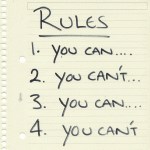 [tweetmeme]
[tweetmeme]
This last week I was at the Marcus Evans Open Innovation Conference giving a presentation on “The Next Evolution of Openness” – Getting back on the speaking circuit finally gave me a little thinking time away from building a rapidly growing consulting practice at my new company Spigit and I wanted to share with you some of the key points of that talk over the next few blog posts.
 Things change quickly in the Innovation world – and as I was writing the title of the presentation I was struggling whether the word “evolution” was quite the right one – maybe “Revolution” would’ve been a better word to use in the circumstances.
Things change quickly in the Innovation world – and as I was writing the title of the presentation I was struggling whether the word “evolution” was quite the right one – maybe “Revolution” would’ve been a better word to use in the circumstances.
There’s supposed to be an ancient Chinese curse that goes along the lines of “May you live in interesting times” – and I don’t think that times get any more interesting than the business environment we currently find ourselves in.
We live in a time of massive change – both in terms of the size of changes we’re asked to take on, and the frequency with which change now happens.
The recent financial depression has had profound consequences on the businesses that survived. We’ve come out the other end to a world that demands greater accountability, greater participation, and greater transparency than ever before. We’re in the middle of a social revolution where the strength is slowly moving away from corporations and moving into to the hands of the consumer. Where power is moving from the Core of a company to its “Edges”.
As a result, businesses are waking up (rudely in some cases) to a new way of working, a new way of organizing, and a new brand of leadership. Innovation, as a corporate discipline is no different.
 Indeed, if we look at the history of Innovation over the years, there are definite trends to be seen:
Indeed, if we look at the history of Innovation over the years, there are definite trends to be seen:
We started with the lone inventor, working alone to build an advantage that no one else could copy.
If one bright person could achieve an advantage, it didn’t take rocket science to realize that maybe we could put several bright people in the same room and multiply the effect – so we built R&D labs to take advantage of that.
 R&D labs worked well, so we started wondering if anyone else in the company had useful input too – so we invented the suggestion box as a corporate tool.
R&D labs worked well, so we started wondering if anyone else in the company had useful input too – so we invented the suggestion box as a corporate tool.
The advent of technology brought with it the ability to ask a broader range of employees than ever before – reaching out across business silos and traditional geographic boundaries to grab ideas wherever they lay. We started putting effective processes around the use of the technology and Idea Management came about.
Innovation Management came along when we then figured out that ideas without execution were worthless – so we changed to focus on an end to end process that drove the ideas we were collecting all the way through a formal pipeline to execution and thus started creating an engine for creating new value for corporations.
 Collaborative Innovation brought in the concept that people could add value even if they didn’t have an idea themselves. We started using leading edge social technologies to allow people to work together on building ideas together and driving new levels of value creation.
Collaborative Innovation brought in the concept that people could add value even if they didn’t have an idea themselves. We started using leading edge social technologies to allow people to work together on building ideas together and driving new levels of value creation.
Open Innovation brought in the idea that the best ideas didn’t necessarily (and probably didn’t) reside solely within the corporate four walls. So we started to look at sourcing ideas from anywhere and everywhere outside of our own organizations.
We then reevaluated the innovation process – realizing what was really at the heart of our activities was a robust problem solving process and so collaborative problem solving became the big focus.
 When we started considering Innovation as a problem solving process we also then realized that the applicability of what we were doing became broader – we could now push a flow of new ideas across the entire enterprise, building a cultural shift of not just reacting to, but actively driving massive continuous change at all times – We created Enterprise-wide Social Innovation.
When we started considering Innovation as a problem solving process we also then realized that the applicability of what we were doing became broader – we could now push a flow of new ideas across the entire enterprise, building a cultural shift of not just reacting to, but actively driving massive continuous change at all times – We created Enterprise-wide Social Innovation.
So, what’s the next step I hear you ask? For me – it’s realizing that maybe even problems aren’t the right focus – that maybe, just maybe, we need to embrace the larger social revolution and realize that we’re on the brink of a new future for business as a whole.
 That future sees companies using Innovation as the gateway drug on their route to incorporating broad level social feedback and input across every aspect of the enterprise.
That future sees companies using Innovation as the gateway drug on their route to incorporating broad level social feedback and input across every aspect of the enterprise.
That future sees us bringing in and co-creating with the masses to create the ultimate engagement model with would-be customers – that of a conspirator or co-owner in the very business they helped to create.
Maybe then, it’s not Innovation that should be Open – but rather Business as a whole.
 If we just follow the trends from the timeline above, we see that there has always been value in building our companies outwards. That there has always been value in continuously increasing the number of people in “the room”, in increasing the transparency of the organization, in pulling the outside in, and ultimately in the engaging, at scale, the broader world around us.
If we just follow the trends from the timeline above, we see that there has always been value in building our companies outwards. That there has always been value in continuously increasing the number of people in “the room”, in increasing the transparency of the organization, in pulling the outside in, and ultimately in the engaging, at scale, the broader world around us.
That the leaders amongst us are those who are continuously exploring the boundaries of their companies and learning how to embrace the fringes and edges to drive value at the core.
Could this be the Open Business revolution at last?
I look forward to reading your thoughts 🙂



 And by “Engagement” I don’t mean just listening to your employees – I mean actually “Doing” something with their input. Business, and especially Innovation – is a team sport – and no one wants to be relegated to being the guy on the subs bench that never gets on the field.
And by “Engagement” I don’t mean just listening to your employees – I mean actually “Doing” something with their input. Business, and especially Innovation – is a team sport – and no one wants to be relegated to being the guy on the subs bench that never gets on the field.













 [tweetmeme]Always an avid reader of the
[tweetmeme]Always an avid reader of the 
 2) Be Ambitious – There’s an old saying: “Fortune Favors the Brave” – and nowhere else is that truer than in the Innovation game. To score big, you have to aim big. If you only look for incremental ideas, then that’s all you’ll get.
2) Be Ambitious – There’s an old saying: “Fortune Favors the Brave” – and nowhere else is that truer than in the Innovation game. To score big, you have to aim big. If you only look for incremental ideas, then that’s all you’ll get. To that end, maintaining a laser-like focus on what you’re trying to achieve is imperative for an innovation program. Your Innovation strategy needs to be revisited constantly and attacked with the same brutality for embracing change as you’re demanding from the organization with the innovations that you are introducing. Your strategy needs to be a fluid structure with one constant– “How can I best drive significant business results and organic growth for my organization?” – and you should make sure that your processes and actions are targeted at achieving that goal.
To that end, maintaining a laser-like focus on what you’re trying to achieve is imperative for an innovation program. Your Innovation strategy needs to be revisited constantly and attacked with the same brutality for embracing change as you’re demanding from the organization with the innovations that you are introducing. Your strategy needs to be a fluid structure with one constant– “How can I best drive significant business results and organic growth for my organization?” – and you should make sure that your processes and actions are targeted at achieving that goal.


















 Forget about Communities.Don’t do it. Don’t even think about it. Oh I know that communities are all the rage currently – companies are falling over themselves to create, build and own their very own communities: Communities of Employees, Communities of Customers, Communities of Interest Groups, Communities, Communities, Communities….
Forget about Communities.Don’t do it. Don’t even think about it. Oh I know that communities are all the rage currently – companies are falling over themselves to create, build and own their very own communities: Communities of Employees, Communities of Customers, Communities of Interest Groups, Communities, Communities, Communities…. I find that many, maybe even most, companies approach social media, and other online community projects – with very little, if any, forethought on how value will be achieved as a result of jumping on this particular bandwagon.
I find that many, maybe even most, companies approach social media, and other online community projects – with very little, if any, forethought on how value will be achieved as a result of jumping on this particular bandwagon. Unlike in the movie “Field of Dreams” – you can build it – but “they” rarely come spontaneously – or if they do, they may well end up playing a jovial game of scrabble rather than a vintage MLB baseball game on the back lawn.
Unlike in the movie “Field of Dreams” – you can build it – but “they” rarely come spontaneously – or if they do, they may well end up playing a jovial game of scrabble rather than a vintage MLB baseball game on the back lawn. There’s a lot of nice words and feelings in that definition. “A social group”; “common heritage”; “interacting populations”; “shared identity”….The word conjures up a nice warm vision of a collection of friends and associates sitting around a fireside or, for the more cynical among you, images of suburban old age homes in Florida and Arizona maybe.
There’s a lot of nice words and feelings in that definition. “A social group”; “common heritage”; “interacting populations”; “shared identity”….The word conjures up a nice warm vision of a collection of friends and associates sitting around a fireside or, for the more cynical among you, images of suburban old age homes in Florida and Arizona maybe. At the recent
At the recent 




